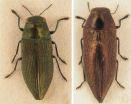(Press-News.org) PROVIDENCE, R.I. [Brown University] — In the last decade, minorities have poured into nursing homes at a time when whites have left in even greater numbers, according to a new Brown University study that suggests a racial disparity in elder care options in the United States.
At first blush the analysis, published July 7 in the journal Health Affairs, suggests that elderly blacks, Hispanics, and Asians are gaining greater access to nursing home care. But the growing proportion of minorities in nursing homes is coming about partly because they do not have the same access to more desirable forms of care as wealthier whites do, said the study's lead author Zhanlian Feng, assistant professor of community health in the Warren Alpert Medical School of Brown University.
"Seemingly, we are closing the gap in terms of minority access to nursing home beds, but I don't think that is something to celebrate," Feng said. "They are really the last resort. Most elders would rather stay in their homes, or some place like home, but not a nursing home unless they have to."
The new analysis shows that between 1999 and 2008 the nation's nursing home population shrank by 6.1 percent to just over 1.2 million people. In that time period the number of whites in nursing homes decreased by 10.2 percent nationwide, while the number of blacks rose 10.8 percent, the number of Hispanics rose by 54.9 percent and the number of Asians rose by 54.1 percent. The study also looked at nursing home population changes in the top 10 metropolitan areas for each minority.
Prior research has shown that the nursing homes in predominately minority areas are often of lower quality and are more likely to close, while assisted living facilities are more likely to be built in areas where residents have high incomes. The result, reflected in the figures in the new Health Affairs paper, is a disparity that plays out not only economically and geographically, but also racially, Feng said.
"We know those alternatives are not equally available, accessible, or affordable to everybody, certainly not to many minority elders," he said.
As policymakers look to "rebalance" elder care from nursing homes to other forms of care, for instance with shifts in Medicaid funding to support home and community-based services, they should account for these disparities, Feng said. As it is, whites are clearly more likely to be using more desirable alternatives; more concerted efforts may be required to promote minority elders' use of them too, he said.
"Rebalancing is a recognition of most people's preferences for long-term care," Feng said. "For that effort to be successful you have to consider who is using what."
To determine the figures, Feng and his co-authors used the federally mandated Minimum Data Set, which tracks the population of nursing home users and assesses their care needs on a routine basis, because they receive substantial Medicare and Medicaid funding. Similar data is not available for other kinds of elder care, which is predominantly paid for with private insurance dollars.
Metropolitan shifts
One way Feng and his co-authors have quantified the disparity in eldercare is by grouping metropolitan areas into quartiles based on the proportion of whites, blacks, Hispanics or Asians 65 or older in each area. The researchers found that the representation of blacks, Hispanics and Asians in nursing homes increased as their share of elderly in the total population increased. That correlation did not hold for whites, who did not appear to be obliged to choose nursing homes as they age.
In New York, a top 10 metropolitan area for blacks, Hispanics and Asians, nursing home residents from these groups increased 22 percent, 84 percent and 40 percent, respectively. In Los Angeles/Long Beach, the increases were 1 percent for blacks, 41 percent for Hispanics and 56 percent among Asians.
With different rates in different cities, the challenge facing policymakers is not only national, but also local, the researchers said.
"Efforts to reduce disparities should target both communities and facilities with high concentrations of minority residents," they wrote in Health Affairs.
###
In addition to Feng, the paper's other authors at Brown are Mary Fennell, professor of sociology; Denise Tyler, gerontology researcher; Melissa Clark, associate professor of community health; and Vincent Mor, the Florence Pirce Grant Professor of Health Services, Policy, and Practice.
The National Institute on Aging supported the research.
New disparity in nursing homes: Whites leave, minorities enter
2011-07-08
ELSE PRESS RELEASES FROM THIS DATE:
DNA decoded by FSU biologist reveals 7 new mice species
2011-07-08
After living incognito for millions of years in a remote area of a forested mountain range in the Philippines, seven newfound species of mice owe their recent discovery to DNA evidence and the Florida State University biologist who deciphered it.
What's more, the DNA drawn from the reclusive "new" mammals told FSU Associate Professor Scott J. Steppan an unusual evolutionary story. As he analyzed and compared the genetic codes of mice found in separate but proximate parts of a small area on Luzon, the largest Philippine island, he determined that while each mouse was a ...
Research shows generic medications are changing the economics of treating chronically ill patients
2011-07-08
WOONSOCKET, R.I. – July 7, 2011 – As the nation seeks to expand health care coverage to more citizens without adding burdensome costs, researchers from Harvard University, Brigham and Women's Hospital and CVS Caremark reported that preventative health care may be significantly less costly than previously thought, due to expanded use of cost-effective generic medications for the treatment and prevention of chronic disease.
A study released today in the July issue of Health Affairs concludes that preventive health care is considerably less costly than previous industry ...
NIST prototype 'optics table on a chip' places microwave photon in 2 colors at once
2011-07-08
Researchers at the National Institute of Standards and Technology (NIST) have created a tunable superconducting circuit on a chip that can place a single microwave photon (particle of light) in two frequencies, or colors, at the same time.
This curious "superposition," a hallmark of the quantum world, is a chip-scale, microwave version of a common optics experiment in which a device called a beam-splitter sends a photon into either of two possible paths across a table of lasers, lenses and mirrors. The new NIST circuit can be used to create and manipulate different quantum ...
California groundwater management trickles up from local sources
2011-07-08
In a typical year, California gets about 30 percent of its water from groundwater wells. Yet when it comes to managing this precious resource, the state of California relies on a mixed bag of more than 2,000 local water agencies with varying degrees of authority.
Critics say that this decentralized system leaves the state vulnerable to overdraft, which occurs when water is pumped out faster than replacement water is absorbed. But according to a new report published by Stanford University's Program on Water in the West, a surprising number of local water districts are ...
Graphene: What can go wrong? new studies point to wrinkles, process contaminants
2011-07-08
Using a combination of sophisticated computer modeling and advanced materials analysis techniques at synchrotron laboratories, a research team led by the University at Buffalo (UB) and including the National Institute of Standards and Technology (NIST), the Molecular Foundry at Lawrence Berkeley National Laboratory and SEMATECH* has demonstrated how some relatively simple processing flaws can seriously degrade the otherwise near-magical electronic properties of graphene.
Their new paper** demonstrates how both wrinkles in the graphene sheet and/or chance contaminants ...
Promising fire retardant results when clay nanofiller has space
2011-07-08
If materials scientists accompanied their research with theme songs, a team from the National Institute of Standards and Technology (NIST) and the University of Maryland (UMD) might be tempted to choose the garage punk song "Don't Crowd Me"* as the anthem for the promising, but still experimental nanocomposite fire retardants they are studying.
That's because the collaborators have demonstrated that the more widely and uniformly dispersed nanoscale plates of clay are in a polymer, the more fire protection the nanocomposite material provides.
Writing in the journal Polymer,** ...
Study suggests new strategy to prevent infertility, birth defects
2011-07-08
A strategy that has been shown to reduce age-related health problems in several animal studies may also combat a major cause of age-associated infertility and birth defects. Investigators from Massachusetts General Hospital (MGH) have shown that restricting the caloric intake of adult female mice prevents a spectrum of abnormalities, such as extra or missing copies of chromosomes, that arise more frequently in egg cells of aging female mammals. Their report appears in this week's online Early Edition of the Proceedings of the National Academy of Sciences USA.
"We found ...
The Brava System: How Does it Work?
2011-07-08
Brava breast enhancement is a clinically proven, nonsurgical method for enlarging your breasts. Brava utilizes tissue expansion, a method for enabling your body to grow extra skin tissue.
Brava consists of two domes with silicone gel rims that are worn over the breasts and held in place with a sports bra. A battery-powered microcomputer called a SmartBox creates and regulates a light vacuum within the domes.
This gentle tension within the domes stimulates tissue cells, causing them to multiply and generate new breast tissue. As new tissue develops, your breast size ...
Jewel beetles, obtained from local people, turn out to be 4 species unknown to science
2011-07-08
A team of researchers from the Czech University of Life Sciences discovered four new species of jewel beetles (Buprestidae) from South-eastern Asia. This family of beetles is named for their particularly beautiful body and fascinating, shiny colours.
"All new species belong to the genus Philanthaxia. Before the publication of this study, 61 species had been known from this genus. Currently, it comprises of 65 species, with a primarily Southeast-Asian distribution, except for two species extending to the Australasian region", said Oto Nakládal, a co-author of the study.
The ...
In a Car Wreck? Use the Ferrer Shane Accident Toolkit iPhone App
2011-07-08
In a world - a mobile world - where the words "cool" and "useful" are the primary ways to describe smartphone apps worth buying, apps provided by law firms have very seldom been described as cool or useful.
Will the Accident Toolkit, sponsored by the Miami personal injury lawyers of Ferrer Shane, be any different?
It actually might.
Many commentators have stated that lawyers' smartphone apps are just another marketing gimmick and will do very little to attract consumer interest, especially when it comes to those apps that are likely to be ...



